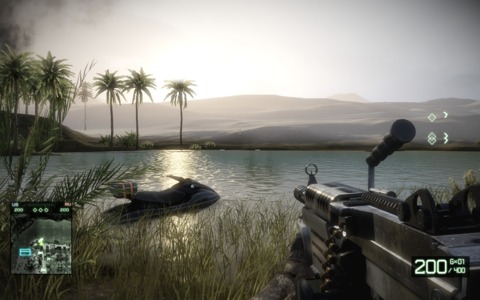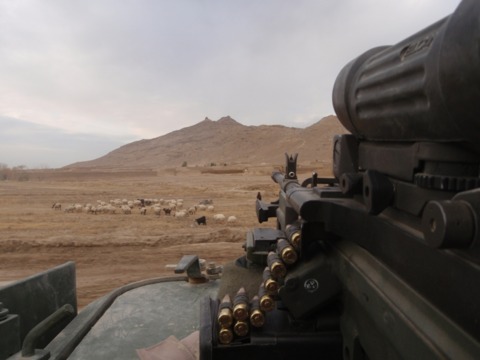History
Since the dawn of warfare, man has sought to create a weapon that fires faster then the rest. For many hundreds of years, this came usually in the form of a archer with a quick hand or a specially designed rapid firing crossbow (Chu-Ko-Nu). It would not be until the 18th (the virtually unused Puckle Gun) and 19th centuries that these ideas would become a reality. The first "machine gun" in a sense was the hand-cranked Gatling gun which found some use in the latter half of the 19th century. However, the Maxim machine gun is considered the first true machine gun. Designed and produced in the very late 19th and early 20th centuries, the Maxim machine gun changed once more the way wars were fought. The mass produced machine gun while not solely responsible was certainly instrumental to the carnage and death of the First World War. Unprotected and poorly trained infantry were thrown senselessly at much better defended and armed machine guns. What ensued were 4 years of slaughter.
After the First World War, strategy, tactics and with them the machine guns changed drastically. Unlike the cumbersome and bulky machine guns of WW1, the machine guns of World War 2 were fairly light, fired faster, had more powerful ammunition, and were much more common. Almost every platoon in every nation's military had a squad support light machine gun. Probably the most famous machine gun of this era was the legendary MG42 used by the Germans. Capable of the still staggering 1200 rounds per minute, countless men died by the MG42s hail of lead. After WW2 and during the Cold War, machine guns evolved even further. On average, they nowadays split into two distinctive categories.
With modern day infantry tactics one commonly finds a light machine gun within every squad. Used mainly for suppressive fire their caliber is chosen smaller which in turn allows the gunner to carry a lot more ammo and keeps the whole weapon system lighter and more compact. In comparison heavy machine guns are mostly used in fixed positions or mounted on a vehicle. They use bigger calibers and significantly outrange the smaller counterparts. As well as allowing to shoot through much heavier coverage they are quite capable of disabling lightly armored vehicles.
Design
Machine guns can vary quite dramatically in terms of design, but most modern weapons of this class share several common features.
Barrel
 Light Machine Gun ( LMG) in Battlefield Bad Company 2
Light Machine Gun ( LMG) in Battlefield Bad Company 2Machine guns often have a heavier barrels in order to handle the immense heat generated by the large volumes of bullets they fire in combat. Even still, firing too much can cause barrels to eventually glow red- or even white-hot with heat. This can reduce the rate of fire with fouling and can eventually cause permanent damage to the barrel. Many modern weapons are capable of quickly changing barrels to a spare; this allows the heated barrel to cool off while the fresh barrel is good for firing another couple hundred rounds. This is why many machine guns have a distinctive handle on the barrel, so that it may be gripped without burning the operator's hands. For most machine guns, a barrel change is meant to be performed every 200 to 400 rounds fired. To the left is an example of an M249 machine gun with the handle for barrel changing visible. Some weapons similar in role to machine guns, such as miniguns or larger rotary cannons, actually utilize multiple barrels which do not need to be changed in order to mitigate the buildup of heat. Strictly speaking these weapons are not considered machine guns and have a very different design and method of operation.
Mechanical Operation
Most machine guns are either gas-operated or recoil-operated. Gas operated machine guns use a small tube and a piston to channel gases from firing back to the bolt carrier, so that it may move back and eject the casing. Moving back creates tension on a spring which pushes back forward, grabbing a new round from the ammunition source and moving it forward to be fired. On recoil operated weapons, the sheer force of the round being fired is enough energy to push the bolt carrier back against a spring to cycle the action. This process repeats indefinitely, as long as the trigger is held down. As soon as the operator releases the trigger, the cycle stops - in some extreme cases, a malfunction will cause a machine gun to keep firing until it jams or runs out of ammunition. This type of failure is widely known as a "runaway gun". Open bolt weapons, once readied (or "cocked"), actually keep the bolt back (or open) under spring tension until it is released by the trigger assembly. Closed bolt weapons are readied in the forward position and only require the firing pin to go forward in order to fire the first round.
Ammunition
 200-round box with metal disintegrating link on a LMG
200-round box with metal disintegrating link on a LMGThe greatest advantage of the machine gun is that it is capable of sustained automatic fire. This requires a large source of ammunition, and most weapons of this class rely on either a belt (frequently, but not always, carried in boxes) or spring-loaded magazines similar to pistols, submachine guns, and assault rifles. Belt fed rounds must be linked together with either a cloth or metal link between bullets. This link is discarded as bullets are fired, along with the casings which are normall y produced. Machine guns, being predominately military weapons, are usually designed to fire existing calibers that are easily interchangeable with other military weapons. In some cases, heavy bullets such as the 12.7mm (.50 cal) initially designed for machine guns were later adopted for other uses in smaller weapons. To the right is a real example of a very similar weapon to the M249, the C9 LMG, with the rounds and link clearly visible going into the feed tray.
Video Games
In the world of video games, machine guns are mostly mimicking their practical drawbacks in real life. They are generally heavy, cumbersome, and difficult to use in a standing position. A machine gunner is often very vulnerable to snipers and grenades due to their slow speed and ease of identification. However, machine guns have a massive advantage over other small arms in open combat which is why machine guns are often used to cover key locations. In First and Third Person shooters, machine guns may either be man portable or stationary depending on the machine gun or simply the game itself. Machine guns are usually highly sought after due to their immense firepower and fear inducing qualities.
Log in to comment